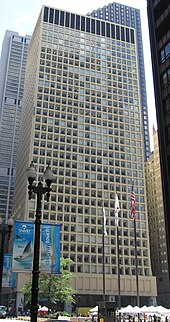Cook County Administration Building
 From Wikipedia - Reading time: 6 min
From Wikipedia - Reading time: 6 min

The Cook County Administration Building (formerly known as the Brunswick Building) is a skyscraper located at 69 West Washington Street in Chicago, Illinois.[1][2] The building, constructed between the years 1962 and 1964, is 475 ft (144.8 m) tall, and contains 35 floors.[1] It has a concrete structure.[1] The building, engineered by Fazlur Khan of the firm Skidmore, Owings & Merrill, is notable for innovating the tube-within-a-tube structural system.[2]
Originally a corporate office building, the tower was later acquired by the Cook County government and now holds county government offices and courtrooms.[2]
Design and construction
[edit]
The building, was constructed between the years 1962 and 1964, and utilizes a concrete structure.[1] At the time of its construction, it was Chicago's tallest concrete office building.[2] The building is designed with an exposed structure and adheres to the modernist architecture style.[2] The building utilizes a deep foundation system.[2]
This was the first building to utilize the shear wall frame interaction system conceptualized by its engineer, Fazlur Khan of the firm Skidmore, Owings & Merrill.[3] Kahn adapted the tube system he had innovated with the design of The Plaza on DeWitt by creating a tube-within-a-tube, with both the building's core and its perimeter being hollow and rigid tubes that support the tower, allowing for column-free interior space.[2]
At its lower portion, the façade of the tower juts back slightly in a curve.[2]
The building is connected to the Chicago Pedway system, with the Pedway featuring retail spaces in the area where it passes beneath the tower.[2] An underground Chicago Pedway passage connects the building to the Richard J. Daley Center across the street.[2]
The building has a small plaza featuring an untitled sculpture by Joan Miró.[2]
Fire
[edit]The Cook County Administration Building saw a structural fire occur on the 12th floor of the building on October 17, 2003.[4][5][6]
The fire was started in a supply room[7] by a faulty light fixture and resulted in the deaths of six people.[8][9] The City of Chicago, in addition to several other defendants, paid $100 million to the families of the six victims after litigation,[10] citing multiple failures.
References
[edit]- ^ a b c d "Cook County Administration Building - The Skyscraper Center". www.skyscrapercenter.com. Retrieved 18 December 2021.
- ^ a b c d e f g h i j k "Cook County Administration Building". Emporis. Archived from the original on May 14, 2015. Retrieved 18 December 2021.
{{cite web}}: CS1 maint: unfit URL (link) - ^ "Major Works - Fazlur Khan - Structural Artist of Urban Building Forms". Khan.princeton.edu. Archived from the original on 22 May 2015. Retrieved 18 June 2014.
- ^ "Fire".
- ^ "govinfo". www.govinfo.gov. Retrieved 2021-03-07.
- ^ "14 Years After 69 West Washington—Fire Reforms Are Still Incomplete". NBC Chicago. Retrieved 2021-03-07.
- ^ Institute, Fire Service. "LibGuides: Significant Illinois Fires: Cook County Administration Building Fire". guides.library.illinois.edu. Retrieved 2021-03-07.
- ^ Mickey Ciokajlo; Sabrina L. Miller; Robert Becker; John Chase; Grace Aduroja; Manya Brachear. "6 die in Loop blaze". Chicago Tribune. Retrieved 2021-03-07.
- ^ Davey, Monica (2003-10-19). "Smoke and Panic on Stairs In Chicago High-Rise Fire". The New York Times. ISSN 0362-4331. Retrieved 2021-03-07.
- ^ Michael Higgins; Dan Mihalopoulos. "Fire lawsuits settled for $100 million". Chicago Tribune. Retrieved 2021-03-07.
 KSF
KSF